fuel cap HONDA S2000 2000 1.G Owners Manual
[x] Cancel search | Manufacturer: HONDA, Model Year: 2000, Model line: S2000, Model: HONDA S2000 2000 1.GPages: 273, PDF Size: 21.58 MB
Page 1 of 273
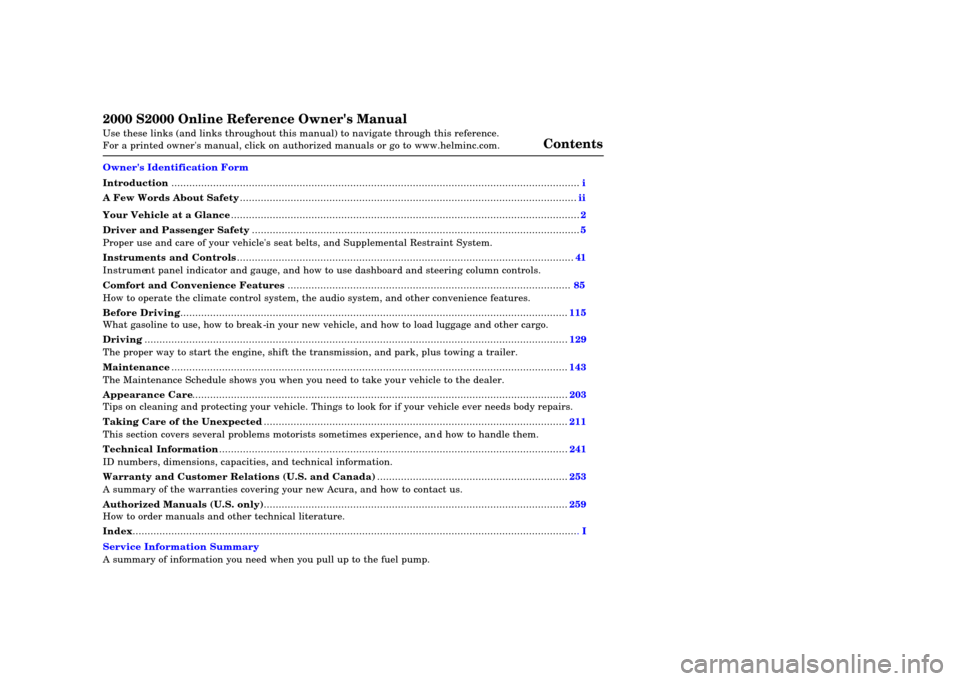
2000 S2000 Online Reference Owner's Manual Use these links (and links throughout this manual) to navigate through\
this reference.
For a printed owner's manual, click on authorized manuals or go to www.h\
elminc.com.
Contents
Introduction ........................................................................\
................................................................. i
A Few Words About Safety........................................................................\
........................................ .ii
Your Vehicle at a Glance........................................................................\
............................................ .2
Driver and Passenger Safety ........................................................................\
......................................5
Proper use and care of your vehicle's seat belts, and Supplemental Restr\
aint System.
Instruments and Controls........................................................................\
........................................ .41
Instrument panel indicator and gauge, and how to use dashboard and steering colu\
mn controls.
Comfort and Convenience Features ........................................................................\
....................... 85
How to operate the climate control system, the audio system, and other c\
onvenience features.
Before Driving........................................................................\
..........................................................115
What gasoline to use, how to break-in your new vehicle, and how to load luggage and other cargo.
Driving ........................................................................\
..................................................................... .129
The proper way to start the engine, shift the transmission, and park, pl\
us towing a trailer.
Maintenance........................................................................\
.............................................................143
The Maintenance Schedule shows you when you need to take yo ur vehicle to the dealer.
Appearance Care........................................................................\
..................................................... .203
Tips on cleaning and protecting your vehicle. Things to look for if your\
vehicle ever needs body repairs.
Taking Care of the Unexpected........................................................................\
..............................211
This section covers several problems motorists sometimes experience, a nd how to handle them.
Technical Information........................................................................\
............................................ .241
ID numbers, dimensions, capacities, and technical information.
Warranty and Customer Relations (U.S. and Canada)................................................................253
A summary of the warranties covering your new Acura, and how to contact \
us.
Authorized Manuals (U.S. only)........................................................................\
..............................259
How to order manuals and other technical literature.
Index........................................................................\
........................................................................\
...... I
Service Information Summary
A summary of information you need when you pull up to the fuel pump. Owner's Identification Form
Page 120 of 273
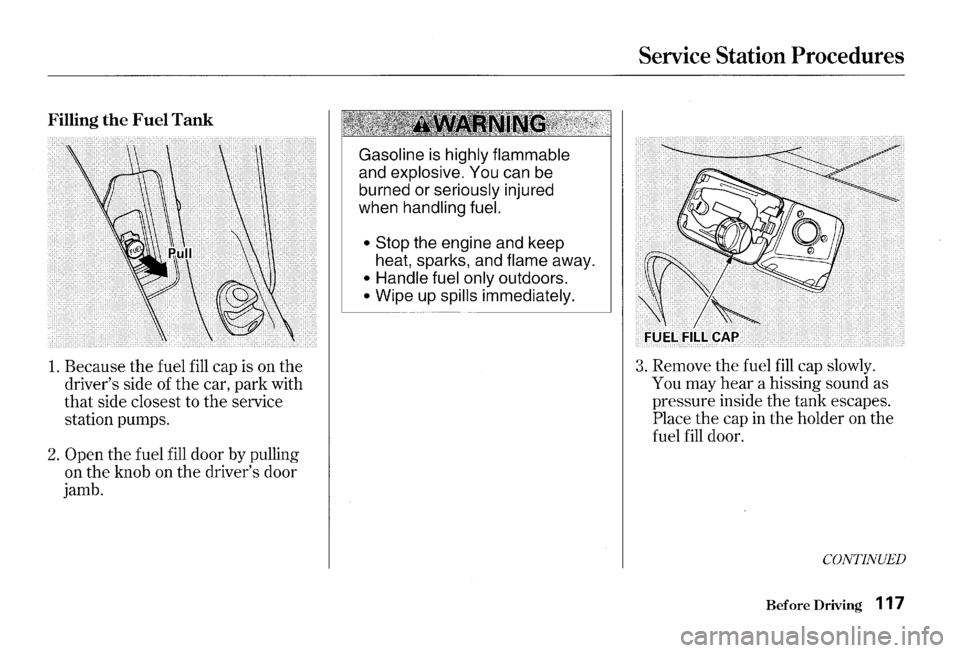
1. Because the fuel fill cap is on the
driver's side of the car, park with
that side closest to the service
station pumps.
2. Open the fuel fill door by pulling
on
the knob on the driver's door
jamb.
Gasoline is highly flammable
and explosive. You can be
burned or
seriously injured
when
handling fuel.
• Stop
the engine and keep
heat, sparks, and
flame away.
• Handle fuel only outdoors.
• Wipe up spills immediately.
Service Station Procedures
3. Remove the fuel fill cap slowly.
You may
hear a hissing sound as
pressure inside
the tank escapes.
Place the cap in the holder on the
fuel fill door.
CONTINUED
Before Driving 117
Page 121 of 273

Service Station Procedures
4. Stop filling the tank after the fuel
nozzle automatically clicks off. Do
not try to
"top off" the tank, leave
some room for the fuel to expand
with temperature changes.
5. Screw the fuel fill cap back on,
tighten it until it clicks at least
three times.
If you do not properly
tighten the cap, the Malfunction
Indicator Lamp may come on (see
page
228 ).
6. Push the fuel fill door closed until
it latches.
118 Before Driving
Opening the Hood
1. Shift to Neutral and set the
parking brake.
Pull the hood
release handle located under the
lower left corner of the dashboard.
The hood will pop up slightly.
2. Standing in front of the car, put
your fingers under the front edge
of the hood to the right of center.
Slide your hand to the left until
you feel the hood latch handle.
Push this handle to the left until it releases
the hood.
Lift the hood.
If you can open the hood without
lifting the hood latch handle, or
the hood latch handle moves
stiffly or does not spring back as
before, the mechanism should
be
cleaned and lubricated (see page
174 ).
Page 160 of 273
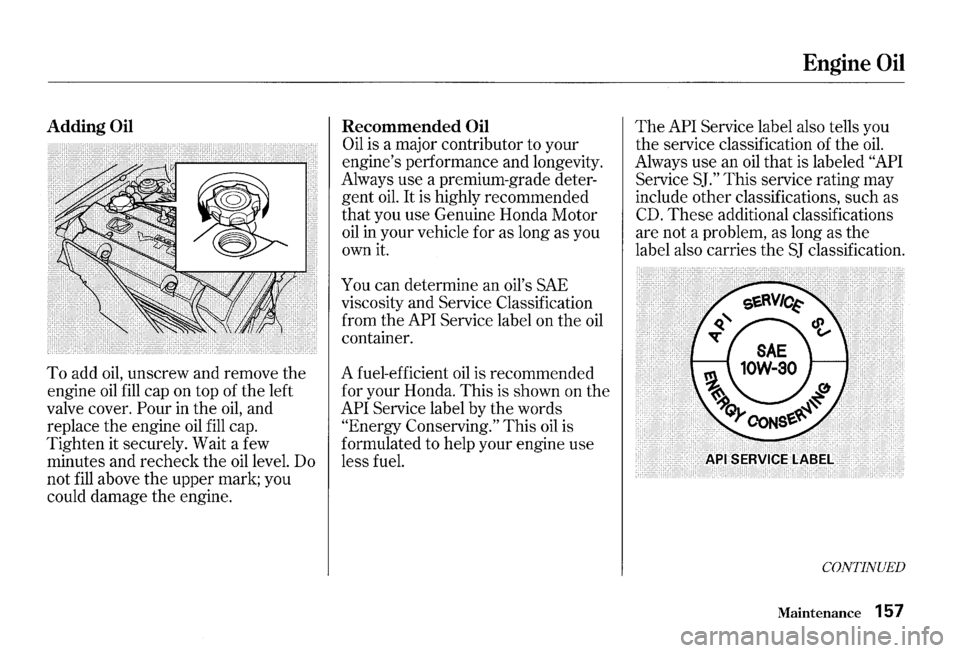
Adding Oil
To add oil, unscrew and remove the
engine oil fill cap on top of the left
valve cover.
Pour in the oil, and
replace
the engine oil fill cap.
Tighten it securely. Wait a few
minutes and
recheck the oil level. Do
not
fill above the upper mark; you
could damage the engine.
Recommended Oil
Oil is a major contributor to your
engine's performance and longevity.
Always use a premium-grade deter
gent
oil. It is highly recommended
that you use Genuine Honda Motor
oil in your vehicle for as long as you
own it.
You can determine an oil's
SAE
viscosity and Service Classification
from
the API Service label on the oil
container.
A fuel-efficient oil is recommended
for your Honda.
This is shown on the
API Service label by the words
"Energy Conserving." This oil is
formulated to help your engine use
less fuel.
Engine Oil
The API Service label also tells you
the service classification of the oil.
Always use an oil that is labeled "API
Service SJ." This service rating may
include other classifications, such as
CD. These additional classifications
are not a problem, as long as the
label also carries
the SJ classification.
CONTINUED
Maintenance 15 7
Page 170 of 273

Check the level in the windshield
washer reservoir at least monthly
during normal usage. In bad weather,
when you use the washers often,
check the level every time you stop
for fuel.
The windshield washer reservoir is
located
in the rear of the engine
compartment on the passenger's side. Check
the reservoir's fluid level by
removing the cap and looking at the
level gauge attached to the cap.
Windshield Washers
Fill the reservoir with a good-quality
windshield washer fluid. This
increases the cleaning capability and
prevents freezing
in cold weather.
When you refill the reservoir, clean
the edges of
the windshield wiper
blades with windshield washer fluid
on a clean cloth. This will help to
condition
the blade edges.
NOTICE
Do not use engine antifreeze or a
vinegar/water solution
in the
windshield washer reservoir.
Antifreeze can damage your car's paint,
while a vinegar/water solution can
damage the windshield washer pump.
Use only commercially-available
windshield washer fluid.
Maintenance 167
Page 231 of 273
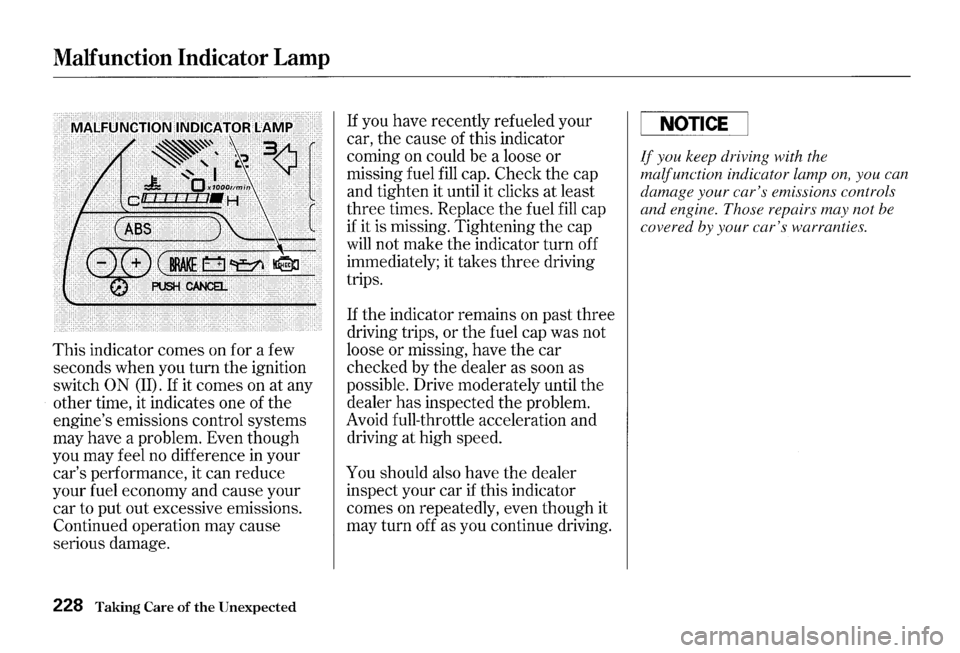
Malfunction Indicator Lamp
This indicator comes on for a few
seconds when you turn the ignition
switch
ON (II). If it comes on at any
other time, it indicates one of the
engine's emissions control systems
may have a problem. Even though
you may feel
no difference in your
car's performance, it can reduce
your fuel economy and cause your
car to put out excessive emissions.
Continued operation may cause
serious damage.
228 Taking Care of the Unexpected
If you have recently refueled your
car, the cause of this indicator
coming on could be a loose or
missing fuel
fill cap. Check the cap
and tighten it until it clicks at least
three times. Replace the fuel
fill cap
if it is missing. Tightening the cap
will not make the indicator turn off
immediately; it takes three driving
trips.
If the indicator remains on past three
driving trips, or the fuel cap was not
loose or missing, have the car
checked by the dealer as soon as
possible. Drive moderately until the
dealer has inspected the problem.
Avoid full-throttle acceleration and
driving at high speed.
You should also have the dealer
inspect your car
if this indicator
comes on repeatedly, even though it
may turn off as you continue driving.
NOTICE
If you keep driving with the
malfunction indicator lamp on, you can
damage your car's emissions controls
and engine. Those repairs may not be
covered by your car's warranties.
Page 244 of 273

The diagrams in this section give
you the dimensions and capacities
of
your Honda, and the locations of the
identification numbers.
The expla
nations of several electronic and
mechanical systems on your Honda
are for the more technically-oriented
owner. Identification
Numbers .................
242
Specifications ................................. 244
DOT Tire Quality Grading
(U.S. Vehicles) ....................... 246
Treadwear .................................. 246
Traction ....................................... 246
Temperature .............................. 247
Technical Information
Oxygenated Fuels .......................... 248
Driving in Foreign Countries ....... 249
Emissions Controls ........................ 250
The Clean Air Act.. .................... 250
Crankcase Emissions Control
System .....................................
250
Evaporative Emissions Control
System .....................................
250
Exhaust Emissions Controls .... 251
PGM-FI System ..................... 251
Ignition Timing Control
System .................................
251
Secondary Air Injection
System .................................
251
Three Way Catalytic
Converter.. ..........................
251
Replacement Parts ..................... 251
Three Way Catalytic Converter ... 252
Technical Information 241
Page 247 of 273
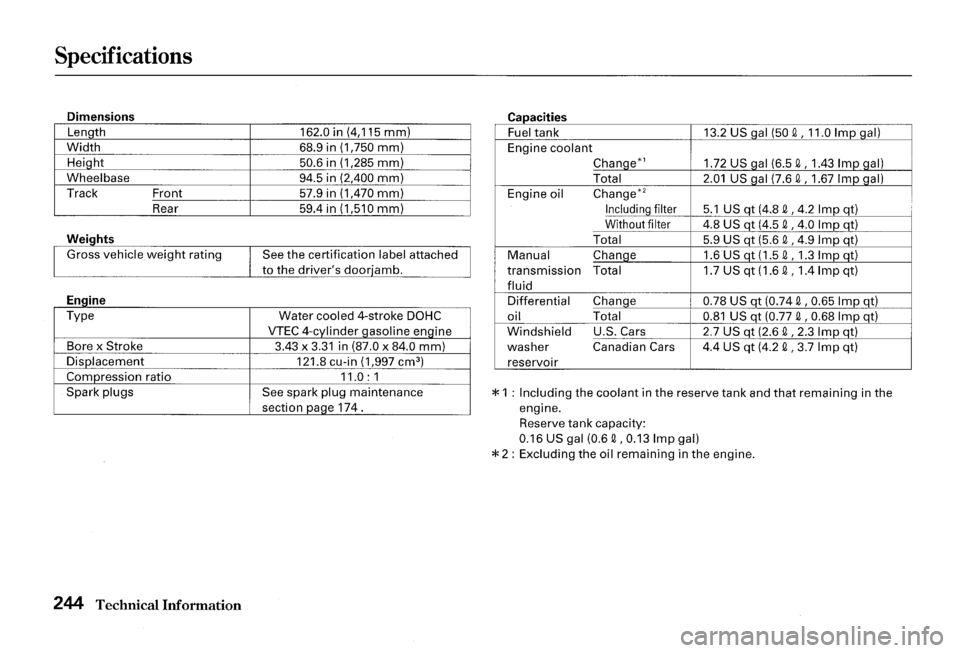
Specifications
Dimensions
Length
Width Height
Wheelbase Track Front
Rear
Engine
Type
Bore x Stroke
Displacement
Compression ratio
Spark plugs
244 Technical Information
162.0in(4,115mm) 68.9 in (1,750 mm)
50.6 in (1,285 mm) 94.5 in (2,400 mm)
57.9 in (1,470 mm)
59.4 in (1,510 mm)
See the certification label attached to the driver's door"amb.
Water cooled 4-stroke DOHC
VTEC 4-cylinder l=)asoline engine
3.43 x 3.31 in (87.0 x 84.0 mm)
121.8 cu-in (1,997 cm3
)
11.0 : 1 See spark plug maintenance
section page
174.
c apac1t1es
Fuel tank 13.2 US
aal (50 ll, 11.0 Imp qal)
Engine coolant
Change*'
1.72 US aal (6.51\, 1.43 Imp qal)
Total 2.01 US l=)al (7.61\, 1.67 Imp gal)
Engine oil Change*'
Including filter 5.1 US qt (4.81\, 4.2 Imp qt)
Without
filter 4.8 USgt (4.51\, 4.0 Imp qt)
Total 5.9 US qt (5.61\, 4.9 Imp qt)
Manual Chanl=)e 1.6 US_g_t (1.51\, 1.31mp qt)
transmission Total 1.7 US qt (1.61\, 1.41mp qt) fluid
Differential Chan_g_e 0.78 US qt (0.741\, 0.65 Imp qt)
oil Total 0.81 US qt (0.77 ll, 0.68 Imp at)
Windshield U.S. Cars 2.7 US qt (2.61\, 2.3 ImP at)
washer Canadian Cars 4.4 US qt (4.21\, 3.7 Imp qt)
reservoir
* 1 : Including the coolant in the reserve tank and that remaining in the
engine. Reserve tank capacity:
0.16 US gal (0.61\, 0.131mp gal)
* 2: Excluding the oil remaining in the engine.
Page 267 of 273
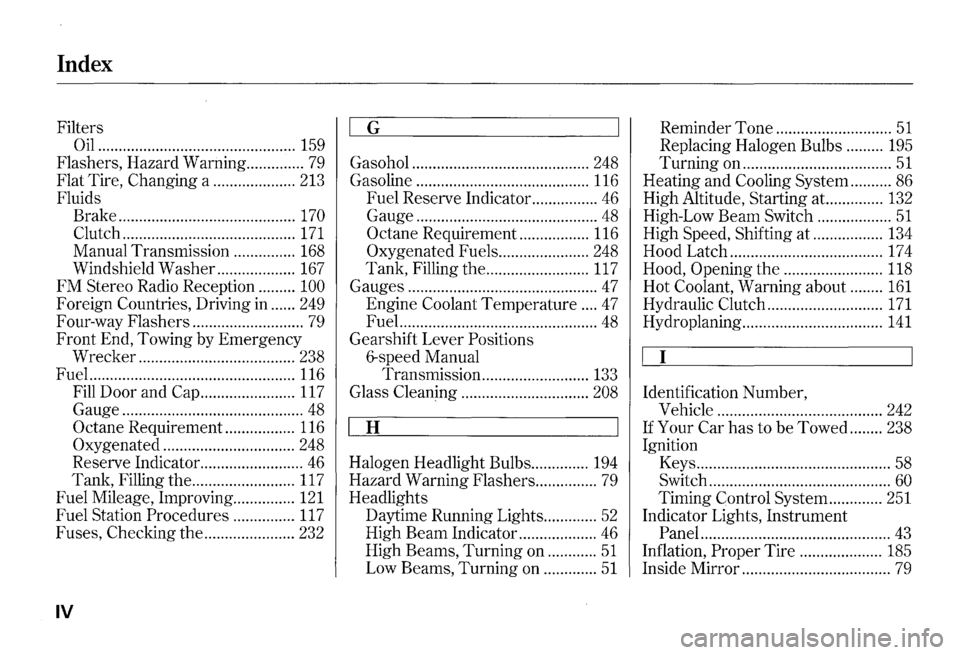
Index
Filters
Oil ................................................ 159
Flashers, Hazard Warning .............. 79
Flat Tire, Changing a .................... 213
Fluids
Brake ...........................................
170
Clutch
.......................................... 171
Manual Transmission ............... 168
Windshield Washer ................... 167
FM Stereo Radio Reception ......... 100
Foreign Countries, Driving in ...... 249
Four-way Flashers ........................... 79
Front End, Towing by Emergency
W reeker ......................................
238
Fuel .................................................. 116
Fill Door and
Cap ....................... 117
Gauge ............................................ 48
Octane Requirement.. ............... 116
Oxygenated ................................ 248
Reserve Indicator .........................
46
Tank, Filling the ......................... 117
Fuel Mileage, Improving ............... 121
Fuel Station Procedures ............... 117
Fuses, Checking the ...................... 232
IV
G
Gasohol ........................................... 248
Gasoline .......................................... 116
Fuel Reserve Indicator. ...............
46
Gauge ............................................ 48
Octane Requirement ................. 116
Oxygenated Fuels ...................... 248
Tank, Filling the .........................
117
Gauges .............................................. 47
Engine Coolant Temperature .... 47
Fuel ................................................ 48
Gearshift Lever Positions
6-speed Manual
Transmission ..........................
133
Glass Cleaning ............................... 208
IH
Halogen Headlight Bulbs .............. 194
Hazard Warning Flashers ............... 79
Headlights
Daytime Running Lights .............
52
High Beam Indicator ................... 46
High Beams, Turning on ............ 51
Low Beams, Turning on ............. 51
Reminder Tone ............................ 51
Replacing Halogen Bulbs ......... 195
Turning on .................................... 51
Heating and Cooling System .......... 86
High Altitude, Starting at.. ............ 132
High-Low Beam Switch .................. 51
High Speed, Shifting at ................. 134
Hood Latch ..................................... 17 4
Hood, Opening
the ........................ 118
Hot Coolant, Warning about ........ 161
Hydraulic Clutch ............................ 171
Hydroplaning .................................. 141
I
Identification Number,
Vehicle ........................................
242
If Your Car has to be Towed ........ 238
Ignition
Keys ...............................................
58
Switch ............................................ 60
Timing Control System ............. 251
Indicator Lights, Instrument
Panel .............................................. 43
Inflation, Proper Tire .................... 185
Inside Mirror .................................... 79
Page 273 of 273
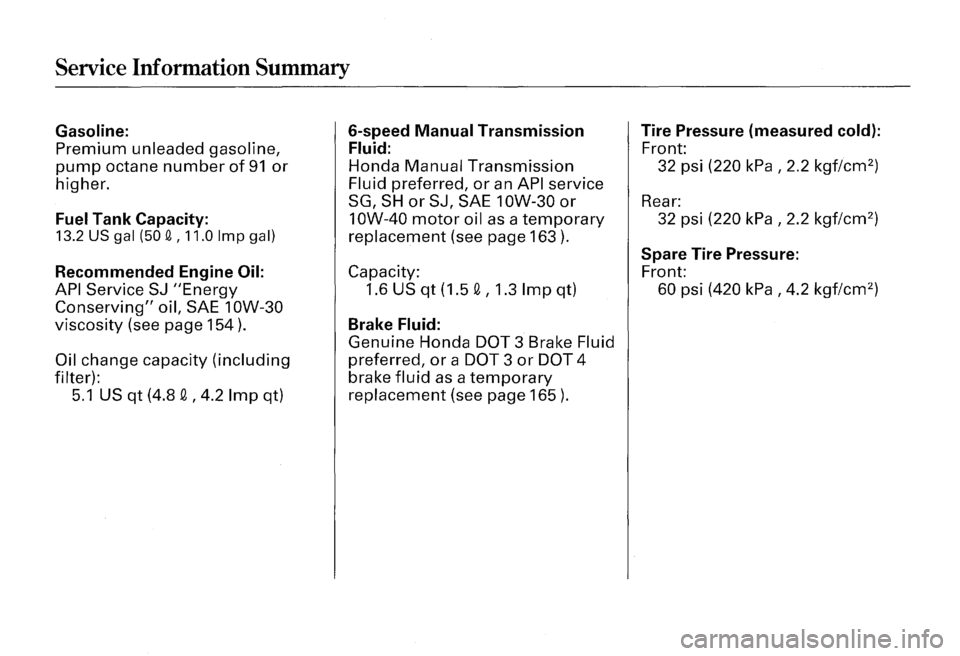
Service Information Summary
Gasoline:
Premium unleaded gasoline,
pump octane number of 91 or
higher.
Fuel Tank Capacity:
13.2 US gal (50~, 11.0 Imp gal)
Recommended Engine Oil:
API
Service SJ "Energy
Conserving" oil, SAE 1 OW-30
viscosity (see page 154 ).
Oil change capacity (including
filter):
5.1 US qt (4.8 fJ , 4.2 Imp qt) 6-speed
Manual Transmission
Fluid:
Honda Manual Transmission
Fluid preferred, or an API service
SG,
SH or SJ, SAE 1 OW-30 or
10W-40 motor oil as a temporary
replacement (see page 163 ).
Capacity:
1.6 US qt (1.5 Q, 1.3 Imp qt)
Brake
Fluid:
Genuine Honda DOT 3 Brake Fluid
preferred, or a DOT 3 or DOT 4
brake
fluid as a temporary
replacement (see page 165 ).
Tire Pressure (measured cold):
Front:
32 psi (220 kPa , 2.2 kgf/cm2
)
Rear:
32 psi (220 kPa , 2.2 kgf/cm2
)
Spare Tire Pressure:
Front:
60 psi (420 kPa , 4.2 kgf/cm2
)